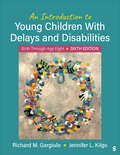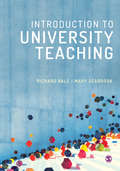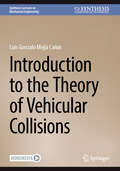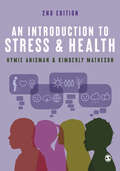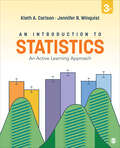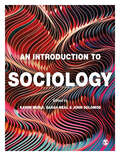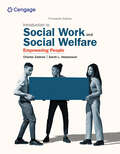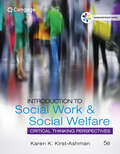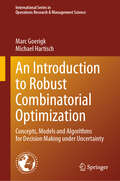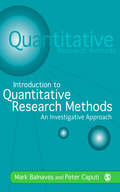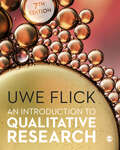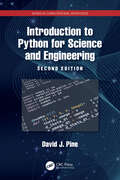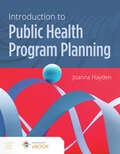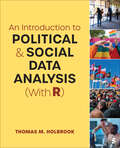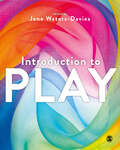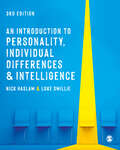- Table View
- List View
An Introduction to Young Children With Delays and Disabilities: Birth Through Age Eight
by Richard M. Gargiulo Jennifer L. KilgoAn Introduction to Young Children With Delays and Disabilities: Birth Through Age Eight introduces readers to educational policies, services, and practices for future educators serving young children birth through age eight with delays and disabilities in early intervention/early childhood special education (EI/ECSE). Thoughtfully and comprehensively addressing the needs of young children and their families, esteemed authors Richard M. Gargiulo and Jennifer L. Kilgo offer interventions and instructional techniques that provide students with a broad understanding of important theoretical and philosophical foundations, including evidence-based decision making, cultural and linguistic responsiveness, and appropriate instruction and interventions in classroom settings and beyond. The Sixth Edition has been thoroughly updated to incorporate the Initial Practice-Based Professional Preparation Standards for Early Interventionists/Early Childhood Special Educators developed by the Division for Early Childhood (DEC) and Council for Exceptional Children (CEC) in 2020, as well as the DEC Recommended Practices. The revised text reflects these standards and practices in crucial content around assessment processes, partnering with families, teaming and collaboration, and services in natural environments, among many other updates to provide contemporary information and resources for future educators.
An Introduction to Young Children With Delays and Disabilities: Birth Through Age Eight
by Richard M. Gargiulo Jennifer L. KilgoAn Introduction to Young Children With Delays and Disabilities: Birth Through Age Eight introduces readers to educational policies, services, and practices for future educators serving young children birth through age eight with delays and disabilities in early intervention/early childhood special education (EI/ECSE). Thoughtfully and comprehensively addressing the needs of young children and their families, esteemed authors Richard M. Gargiulo and Jennifer L. Kilgo offer interventions and instructional techniques that provide students with a broad understanding of important theoretical and philosophical foundations, including evidence-based decision making, cultural and linguistic responsiveness, and appropriate instruction and interventions in classroom settings and beyond. The Sixth Edition has been thoroughly updated to incorporate the Initial Practice-Based Professional Preparation Standards for Early Interventionists/Early Childhood Special Educators developed by the Division for Early Childhood (DEC) and Council for Exceptional Children (CEC) in 2020, as well as the DEC Recommended Practices. The revised text reflects these standards and practices in crucial content around assessment processes, partnering with families, teaming and collaboration, and services in natural environments, among many other updates to provide contemporary information and resources for future educators.
Introduction to University Teaching
by Mary Seabrook Richard BaleThe essential guide to teaching and learning in higher education for early career academics, postgraduate researchers, graduate teaching assistants and professional services staff. This accessible text offers practical guidance for anyone new to teaching in higher education. It covers key aspects of teaching and learning relevant for early career academics, postgraduate researchers, graduate teaching assistants and professional services staff, including those working towards Advance HE/Higher Education Academy (HEA) recognition. Understand how to plan and evaluate teaching sessions, the dynamics of teaching in small and large groups, how to use technology effectively, the particular challenges of laboratory and fieldwork and the importance of inclusive practice and career development. Key features include: · Practical strategies to enhance student learning and motivation. · Case studies from higher education professionals in various roles · Activities and reflection points applying educational principles to your own teaching · Chapter links to the UK Professional Standards Framework (UKPSF)
Introduction to University Teaching
by Mary Seabrook Richard BaleThe essential guide to teaching and learning in higher education for early career academics, postgraduate researchers, graduate teaching assistants and professional services staff. This accessible text offers practical guidance for anyone new to teaching in higher education. It covers key aspects of teaching and learning relevant for early career academics, postgraduate researchers, graduate teaching assistants and professional services staff, including those working towards Advance HE/Higher Education Academy (HEA) recognition. Understand how to plan and evaluate teaching sessions, the dynamics of teaching in small and large groups, how to use technology effectively, the particular challenges of laboratory and fieldwork and the importance of inclusive practice and career development. Key features include: · Practical strategies to enhance student learning and motivation. · Case studies from higher education professionals in various roles · Activities and reflection points applying educational principles to your own teaching · Chapter links to the UK Professional Standards Framework (UKPSF)
Introduction to the Theory of Vehicular Collisions (Synthesis Lectures on Mechanical Engineering)
by Luis Gonzalo Mejía CañasThe phenomena that occur during a vehicle collision are extremely complex, to such an extent that car manufacturers are forced to carry out full-scale tests in order to draw conclusions about vehicle behavior. Fortunately, for the engineering calculations required in a collision analysis, equations can be considered, which, with reasonable development, and with good judgment, lead to reliable results. This book seeks to take a first step on the exciting topic of the Theory of Vehicular Collisions, because this field of science has crucial importance, for example, in clarifying circumstances of serious criminal and civil penalties situations. A brief historical review about the development of collisions theory is also included.
An Introduction to Stress and Health
by Hymie Anisman Kimberly MathesonWith a new chapter dedicated to psychosocial and environmental stressors such as racism, climate change, discrimination, collective trauma, and settler colonialism, this fully updated second edition of An Introduction to Stress and Health explains how chronic and acute stress can precipitate changes in the body that exacerbate and contribute to conditions including heart disease, diabetes, and depression. This is the first textbook to blend psychosocial and behavioural neuroscience perspectives, giving you a broad understanding of the immunological, neurochemical, hormonal and growth factor processes that can be influenced by stress. Anisman and Matheson further invite you to consider how different interventions and therapeutic strategies might be used to deal with stress and its consequences on the body. Its lively writing, fascinating case studies and signposts to further reading make this an indispensable guide for postgraduate students taking courses in health psychology, and stress, health, and illness. Hymie Anisman is Professor of Neuroscience at Carleton University. Kimberly Matheson is Research Chair in Culture and Gender Mental Health and Professor of Neuroscience at The Royal Ottawa’s Institute of Mental Health Research and Carleton University.
An Introduction to Stress and Health
by Hymie Anisman Kimberly MathesonWith a new chapter dedicated to psychosocial and environmental stressors such as racism, climate change, discrimination, collective trauma, and settler colonialism, this fully updated second edition of An Introduction to Stress and Health explains how chronic and acute stress can precipitate changes in the body that exacerbate and contribute to conditions including heart disease, diabetes, and depression. This is the first textbook to blend psychosocial and behavioural neuroscience perspectives, giving you a broad understanding of the immunological, neurochemical, hormonal and growth factor processes that can be influenced by stress. Anisman and Matheson further invite you to consider how different interventions and therapeutic strategies might be used to deal with stress and its consequences on the body. Its lively writing, fascinating case studies and signposts to further reading make this an indispensable guide for postgraduate students taking courses in health psychology, and stress, health, and illness. Hymie Anisman is Professor of Neuroscience at Carleton University. Kimberly Matheson is Research Chair in Culture and Gender Mental Health and Professor of Neuroscience at The Royal Ottawa’s Institute of Mental Health Research and Carleton University.
An Introduction to Statistics: An Active Learning Approach
by Jennifer R. Winquist Kieth Alton CarlsonThis updated and reorganized Third Edition of this textbook takes a workbook-style approach that encourages an active approach to learning statistics. Carefully placed reading questions throughout each chapter allow students to apply their knowledge right away, while in-depth activities based on current behavioral science scenarios, each with problem sets and quiz questions, give students the opportunity to assess their understanding of concepts while reading detailed explanations of more complex statistical concepts. Additional practice problems further solidify student learning. Most activities are self-correcting, so if a concept is misunderstood, this misunderstanding is corrected early in the learning process. After working through each chapter, students are far more likely to understand the material than when they only read the material.
An Introduction to Statistics: An Active Learning Approach
by Jennifer R. Winquist Kieth Alton CarlsonThis updated and reorganized Third Edition of this textbook takes a workbook-style approach that encourages an active approach to learning statistics. Carefully placed reading questions throughout each chapter allow students to apply their knowledge right away, while in-depth activities based on current behavioral science scenarios, each with problem sets and quiz questions, give students the opportunity to assess their understanding of concepts while reading detailed explanations of more complex statistical concepts. Additional practice problems further solidify student learning. Most activities are self-correcting, so if a concept is misunderstood, this misunderstanding is corrected early in the learning process. After working through each chapter, students are far more likely to understand the material than when they only read the material.
An Introduction to Sociology
by Karim Murji John Solomos Sarah NealAn Introduction to Sociology is your essential guide to understanding the social forces that shape our lives and the world around us. This innovative textbook introduces you to the key theories, themes, and concepts in the discipline of sociology and helps you to develop as a sociologist by providing comprehensive coverage of all the main areas of study. Presenting you with the history, current debates and recent research developments for each topic, this book covers everything from classical sociologies and traditional subjects such as class, families, and religion, through to more progressive areas like digital society, social media, migration, and the interconnectedness of modern global society. The book′s extensive coverage means it can be used throughout your studies, from first year to final year. Key features: Each chapter is written by an internationally renowned expert who uses specialist insight and the latest research to provide a reliable and up-to-date overview. Includes a selection of unique learning features such as “Hear from the Expert” boxes and “Key Cases” from around the world, as well as reflective activities and revision questions that will enhance your knowledge. Features a section titled “What is sociology useful for?” which includes chapters on the public value of sociology and the role of sociology in contemporary society. The book is supported by a wide-ranging collection of online teaching and learning resources including exclusive video content from SAGE Video, links to SAGE Journal Articles, sample essay questions, and a selection of multiple-choice questions. This definitive text is perfect for first-year sociology undergraduates and anyone studying sociology at university or college level.
An Introduction to Sociology
by Karim Murji John Solomos Sarah NealAn Introduction to Sociology is your essential guide to understanding the social forces that shape our lives and the world around us. This innovative textbook introduces you to the key theories, themes, and concepts in the discipline of sociology and helps you to develop as a sociologist by providing comprehensive coverage of all the main areas of study. Presenting you with the history, current debates and recent research developments for each topic, this book covers everything from classical sociologies and traditional subjects such as class, families, and religion, through to more progressive areas like digital society, social media, migration, and the interconnectedness of modern global society. The book′s extensive coverage means it can be used throughout your studies, from first year to final year. Key features: Each chapter is written by an internationally renowned expert who uses specialist insight and the latest research to provide a reliable and up-to-date overview. Includes a selection of unique learning features such as “Hear from the Expert” boxes and “Key Cases” from around the world, as well as reflective activities and revision questions that will enhance your knowledge. Features a section titled “What is sociology useful for?” which includes chapters on the public value of sociology and the role of sociology in contemporary society. The book is supported by a wide-ranging collection of online teaching and learning resources including exclusive video content from SAGE Video, links to SAGE Journal Articles, sample essay questions, and a selection of multiple-choice questions. This definitive text is perfect for first-year sociology undergraduates and anyone studying sociology at university or college level.
Introduction to Social Work and Social Welfare Empowering People
by Charles Zastrow Sarah L. HessenauerDiscover a thorough overview of today's social work profession with a realistic glimpse into social problems in contemporary society with Zastrow/Hessenauer's best-selling INTRODUCTION TO SOCIAL WORK AND SOCIAL WELFARE: EMPOWERING PEOPLE, 13E. This practical text provides real insights you can apply in practice. Updates highlight the latest developments and emerging issues, from Biden's social welfare policies and self-care for social workers to employment, immigration, mass shootings and the pandemic. You learn to develop new methods for problem solving and empowering clients as the authors present positive strategies within the context of the core values, ethics, skills and knowledge base of today's professional social worker. Updated case studies, exhibits and tables highlight, compare and contrast contemporary social problems and issues. Core content from the Council on Social Work Education (CSWE) aligns with the latest Educational Policy and Accreditation Standards (EPAS).
Introduction to Social Work and Social Welfare: Critical Thinking Perspectives (Mindtap Course List)
by Karen K. Kirst-AshmanDesigned to give you a solid introduction to the profession of social work, INTRODUCTION TO SOCIAL WORK AND SOCIAL WELFARE, 5th Edition helps you understand the issues that social workers address every day. Using a clear and engaging writing style, author Karen K. Kirst-Ashman presents a balanced overview within a unifying theme of critical thinking that will train you to use evaluative skills in your coursework and beyond. In addition, you'll study more efficiently and effectively with accompanying digital resources that provide you with opportunities to complete self-assessments as well as pre- and post-tests for each chapter. Thoughtful case studies throughout the text help to prepare you for your career by showing you what social work practice looks like in different contexts and with different populations.
An Introduction to Robust Combinatorial Optimization: Concepts, Models and Algorithms for Decision Making under Uncertainty (International Series in Operations Research & Management Science #361)
by Michael Hartisch Marc GoerigkThis book offers a self-contained introduction to the world of robust combinatorial optimization. It explores decision-making using the min-max and min-max regret criteria, while also delving into the two-stage and recoverable robust optimization paradigms. It begins by introducing readers to general results for interval, discrete, and budgeted uncertainty sets, and subsequently provides a comprehensive examination of specific combinatorial problems, including the selection, shortest path, spanning tree, assignment, knapsack, and traveling salesperson problems. The book equips both students and newcomers to the field with a grasp of the fundamental questions and ongoing advancements in robust optimization. Based on the authors’ years of teaching and refining numerous courses, it not only offers essential tools but also highlights the open questions that define this subject area.
Introduction to Quantitative Research Methods: An Investigative Approach
by Peter Caputi Mark BalnavesIntroduction to Quantitative Research Methods is a student-friendly introduction to quantitative research methods and basic statistics. It uses a detective theme throughout the text to show how quantitative methods have been used to solve real-life problems. The book focuses on principles and techniques that are appropriate to introductory level courses in media, psychology and sociology. Examples and illustrations are drawn from historical and contemporary research in the social sciences. The original CD-ROM accompanying the book and its content are no longer available.
An Introduction to Qualitative Research
by Uwe FlickContinuing to be THE guide to the whole qualitative research process for students, this book looks at both the theory behind qualitative research and how to put it into practice in your own work. For students across a range of social science disciplines and beyond, this is a must to help you enhance your research project. This edition introduces: a decolonisation of methodologies a range of indigenous, queer and feminist perspectives on methodologies assistance with defending a viva and alternative forms of assessment to suit a changing world. More additions to this seventh edition include a section on the subjectivity of a researcher, and how your identity will shape your research. The further reading has been curated to include more than just western voices, providing you with global perspectives on qualitative research. This text introduces how to sensitively undertake ethical and inclusive research with marginalised groups. This book will help you master a comprehensive understanding of qualitative research.
An Introduction to Qualitative Research
by Uwe FlickContinuing to be THE guide to the whole qualitative research process for students, this book looks at both the theory behind qualitative research and how to put it into practice in your own work. For students across a range of social science disciplines and beyond, this is a must to help you enhance your research project. This edition introduces: a decolonisation of methodologies a range of indigenous, queer and feminist perspectives on methodologies assistance with defending a viva and alternative forms of assessment to suit a changing world. More additions to this seventh edition include a section on the subjectivity of a researcher, and how your identity will shape your research. The further reading has been curated to include more than just western voices, providing you with global perspectives on qualitative research. This text introduces how to sensitively undertake ethical and inclusive research with marginalised groups. This book will help you master a comprehensive understanding of qualitative research.
Introduction to Python for Science and Engineering (ISSN)
by David J. PineIntroduction to Python for Science and Engineering offers a quick and incisive introduction to the Python programming language for use in any science or engineering discipline. The approach is pedagogical and “bottom up,” which means starting with examples and extracting more general principles from that experience. No prior programming experience is assumed.Readers will learn the basics of Python syntax, data structures, input and output, conditionals and loops, user-defined functions, plotting, animation, and visualization. They will also learn how to use Python for numerical analysis, including curve fitting, random numbers, linear algebra, solutions to nonlinear equations, numerical integration, solutions to differential equations, and fast Fourier transforms.Readers learn how to interact and program with Python using JupyterLab and Spyder, two simple and widely used integrated development environments.All the major Python libraries for science and engineering are covered, including NumPy, SciPy, Matplotlib, and Pandas. Other packages are also introduced, including Numba, which can render Python numerical calculations as fast as compiled computer languages such as C but without their complex overhead.
Introduction to Public Health Program Planning
by Joanna HaydenWritten to provide students with the essential program planning skills that they'll need in public health practice, Introduction to Public Health Program Planning offers an accessible and engaging approach to the program planning process. Divided into 3 parts, Introduction to Public Health Program Planning begins with an introduction to the basics of planning, health determinants, and behaviors. It then offers in-depth discussion of the generic planning phases - from assessing needs and planning to implementing and evaluation. The third section explores the four most commonly used planning frameworks, along with three additional planning frameworks that address specific health issues. A final chapter offers guidance on choosing a planning framework.
An Introduction to Political and Social Data Analysis (With R)
by Thomas M. HolbrookAn Introduction to Political and Social Data Analysis (With R) provides students with an accessible overview of practical data analysis while also providing a gentle introduction to R. By starting with statistics first and using just enough R code to generate results, this text helps students focus on learning how to do data analysis while slowly gaining confidence in using R as they progress through the material. This book is structured around learning by doing. Students can follow along in each chapter by reading about statistics and their applications in R, and then running the R code on their own as they work through contemporary political science and social science examples. Author Thomas M. Holbrook patiently explains each step in in the process, avoiding overly complicated jargon and commands. Exercises at the end of chapters feature both conceptual and calculation-based questions so students can check their understanding data analysis and practice using R. At the end of the semester, students can confidently add skills in data analysis with R to their resumes.
An Introduction to Political and Social Data Analysis (With R)
by Thomas M. HolbrookAn Introduction to Political and Social Data Analysis (With R) provides students with an accessible overview of practical data analysis while also providing a gentle introduction to R. By starting with statistics first and using just enough R code to generate results, this text helps students focus on learning how to do data analysis while slowly gaining confidence in using R as they progress through the material. This book is structured around learning by doing. Students can follow along in each chapter by reading about statistics and their applications in R, and then running the R code on their own as they work through contemporary political science and social science examples. Author Thomas M. Holbrook patiently explains each step in in the process, avoiding overly complicated jargon and commands. Exercises at the end of chapters feature both conceptual and calculation-based questions so students can check their understanding data analysis and practice using R. At the end of the semester, students can confidently add skills in data analysis with R to their resumes.
Introduction to Play
by Jane Waters-DaviesThe go-to textbook for everything you need to know about play! Covering ages 0-8, this book explores what play is, why it matters and where and how play happens. Taking you from start to finish on your course, it helps you: Think critically about play and play provision Understand what good practice looks like See how theory translates into real-world settings Explore the issues, debates, and challenges within play and early learning
Introduction to Play
by Jane Waters-DaviesThe go-to textbook for everything you need to know about play! Covering ages 0-8, this book explores what play is, why it matters and where and how play happens. Taking you from start to finish on your course, it helps you: Think critically about play and play provision Understand what good practice looks like See how theory translates into real-world settings Explore the issues, debates, and challenges within play and early learning
An Introduction to Personality, Individual Differences and Intelligence (SAGE Foundations of Psychology series)
by Nick Haslam Luke SmillieWhat does it mean to have a personality? Is emotional intelligence a kind of intelligence? Learn the answers to these questions, as well as everything you need to know about personality, intelligence, and individual differences in the third edition of this clear and accessible textbook. From natural selection to intelligence tests, and from personality disorders to the concept of IQ, the panoramic coverage of this field makes this textbook essential reading for any psychology student on a personality and individual differences course. New to this edition: · Increased coverage of intelligence · ‘Key Theorists’ feature · Discussion questions moved to end-of-chapter to enable in-text assessment Nick Haslam is Professor of Psychology at the University of Melbourne, Australia. Luke Smillie is an Associate Professor of Psychology at the University of Melbourne and director of the Personality Processes Lab.
An Introduction to Personality, Individual Differences and Intelligence (SAGE Foundations of Psychology series)
by Nick Haslam Luke SmillieWhat does it mean to have a personality? Is emotional intelligence a kind of intelligence? Learn the answers to these questions, as well as everything you need to know about personality, intelligence, and individual differences in the third edition of this clear and accessible textbook. From natural selection to intelligence tests, and from personality disorders to the concept of IQ, the panoramic coverage of this field makes this textbook essential reading for any psychology student on a personality and individual differences course. New to this edition: · Increased coverage of intelligence · ‘Key Theorists’ feature · Discussion questions moved to end-of-chapter to enable in-text assessment Nick Haslam is Professor of Psychology at the University of Melbourne, Australia. Luke Smillie is an Associate Professor of Psychology at the University of Melbourne and director of the Personality Processes Lab.
